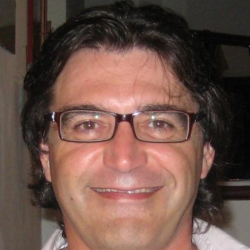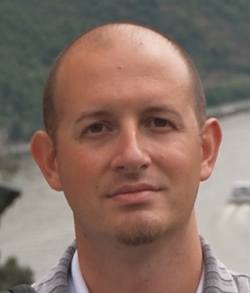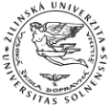Keynotes
Procedural Content Generation Techniques applied to Game Design and Development
Abstract
In the context of video games, Procedural Content Generation (PCG) refers to the automatic creation of contents, performed using algorithms and/or heuristics that are ‐ generally ‐ designed specifically for the game under development. PCG can be exploited to produce different contents, depending on the video game genre and on the peculiarities of the specific game, with the positive effects of reducing development time and increasing randomness of content and/or gameplay. In this invited speech, we will present the researches on PCG conducted in the PONG (Playlab fOr inNovation in Games) laboratory of the Department of Computer Science at University of Milan in the last years.
We have exploited PCG potentialities with different approaches:
- ”classical” PCG for content creation: we have focused our attention on the proposal of procedural-based tools aimed at an optimization of the design process of levels and/or large virtual worlds. In particular, we have shown how PCG can be efficiently applied for the interactive generation of levels for Platformer games, exploiting also the relation between levels structure and musical rhythms. From the experimental evaluation, the resulting levels were considered fun to play, and the design tool allowed a satisfying control on the final desired level of complexity. We have also applied PCG for the generation of imaginary worlds for fantasy video games. We have based the procedural generation on an approximated simulation of the physical phenomena at the basis of the evolution of our planet, starting from the placement of physical elements like mountains, oceans, etc., and then adding inhabited areas to the map. In this stage, the tool has been designed in order to consider specific places created using tools to interactively help the production of narrative structures for stories to include in games.
- PCG based on evolutionary algorithms: we have focused our research on novel methods to exploit the characteristics of Genetic Algorithms (GAs) in the generation of game contents. In particular, we have presented an algorithm to explicitly address the need to introduce more variety and unpredictability in the monsters inside MMOs, in order to avoid that the players consider the game repetitive and less enjoyable after a long period of time spent playing. The main idea was to characterize each monster specie present in the game through its genome, and to generate new species by recombining their chromosomes, which represent a set of physical characteristics and skills. Each monster was represented by a chromosome composed by 53 genes, and the recombination process evaluates also the probability for the new monster to actually survive in the habitat in which it is born. More recently, we have presented a method for the automatic generation of realistic layered materials, based on the application of a GA. We have shown how a GA can be applied efficiently to evolve the parameters of a Bidirectional Scattering Distribution Function (BSDF), in order to generate different versions of a target material presenting a moderate amount of perceptual differences.
- PCG based on Artificial Intelligence (AI) techniques: we have focused our attention on the application of AI and Machine Learning approaches for the generation of believable and unpredictable Non-Playing Characters (NPCs). In particular, we have recently applied Deep Reinforcement Learning for the automatic training of members of a team composed entirely by agents, to play a multiplayer survival shooter game in an unexplored environment. Moreover, we have also considered the introduction of ”emotional states” in the NPCs, by using the internal parameters of a NPC to drive a decision tree representing the tactical and/or strategical beaviour of the virtual agent.
Curriculum Vitae
Davide Gadia has received his M.Sc. (2003) and Ph.D. (2007) in Computer Science from the University of Milan. Currently he is Assistant Professor at Department of Computer Science at University of Milan. His research interests concern mainly Computer Graphics, Video Game programming, Virtual Reality, and Digital Imaging. He is also interested in the processing of stereoscopic images and videos, and in the analysis of perceptual issues in the interaction with Virtual Environments. He is involved in the research activities of the Pong (Playlab fOr inNovation in Games) Laboratory.
The Highs and Lows of Natural Language Learning Gamification
Abstract
Gamification of language learning is a clear trend of recent years. Widespread use of smartphones and the rise of mobile gaming as a popular leisure activity contribute to the popularity of gamification, as application developers can rely on an unprecedented reach of their products and expect acceptance of game-like elements by the users. In terms of content, however, most apps implement traditional language learning activities, such as reading, listening, translating, and solving quizzes. In the present talk, I will discuss what makes gamification of language learning a very challenging task, and outline some success stories as well as failed attempts. We will also consider technologies and approaches that have potential in this area as well as issues that make their practical use difficult at the present moment.
Curriculum Vitae
Maxim Mozgovoy is an associate professor at the University of Aizu, Japan. He received his PhD degree in Applied Mathematics from St. Petersburg State University, and his PhD in Computer Science from University of Joensuu. His main research interests are focused on natural language processing and artificial intelligence for computer games. His current primary goal is to apply machine learning technologies to the task of practical game AI creation. Maxim has a solid academic record of over 70 published articles and industrial-level software development experience. In particular, he is the primary developer of a machine learning-based AI of the mobile tennis game World of Tennis: Roaring '20s.
Evaluation of a VR system for Pain Management using Binaural Acoustic Stimulation
Abstract
The system proposed is oriented to evaluate the pain perceived by the user under a high controlled virtual reality environment (VR). A VR system is an implementation of a virtual world that the user perceives as being there alone. The sensation of immersion affects the stimulus (visual, acoustic and haptic) perceived by the user and it is able to promote change in the brainwaves power and produce an activation of Autonomic Nervous System (ANS). The Electro-Dermal Activity (EDA) allows for measuring the electrical properties of the skin by the sweat activity. This work proposes a VR environment combined with binaural beats (binaural sounds) and visual stimulus to evaluate the perception that the user has and comparing their sensation with real physiological data. It is believed that the use of different binaural beats over a long period of time can help patients to induce a relaxation state (mood) and consequently modulate the perception to pain. In this study we show two experiments. The first one applies 8 types of acoustic stimulus (4 binaural and 4 monaural) in a standard simple VR scenario and we propose the end-users to select the experimented feeling they felt in any case, in parallel using the Empatica wristband we contrast the subjective users' answers with physiological values given by the device. In the second experiment, an immersive environment based on the whole VR application is proposed for control and real users to evaluate chronic pain.The users are immersed in three VR equal scenarios but with random sound stimulation. With the results obtained, we can conclude that binaural beats work better than non-binaural beats if we talk about relaxation and meditation.
Curriculum Vitae
Dr. Francisco J. Perales is a senior researcher in the area of computer graphics and vision, human computer interaction and neurorehabilitation. He obtained his BS and MS in computer science at the Universidad Autonoma de Barcelona (UAB) in 1986. In 1993 he obtained a Master of Digital Image Processing at the UAB. He received a Ph.D.degree in Computer Science at the Universitat de les Illes Balears (UIB) in 1993. In 2013 he obtained a Master of Medicine at the UIB. He is currently pursuing a second Ph.D. in neurorehabilitation using serious games and biofeedback. He is a full professor in the Department of Mathematics and Computer Science at UIB (2017) and head of the Computer Graphics and Vision Group and Artificial Intelligence of UIB. He is an IEEE senior member (1995-2018). He was a visitant professor at University of Tübingen at the Institute for Medical Psychology and Behavioural Neurobiology.

Dr. Francisco José Perales López
Catedrático de Universidad CCeIA
Dep. Matemáticas e Informatica, UIB
Palma de Mallorca, Illes Balears
Spain






